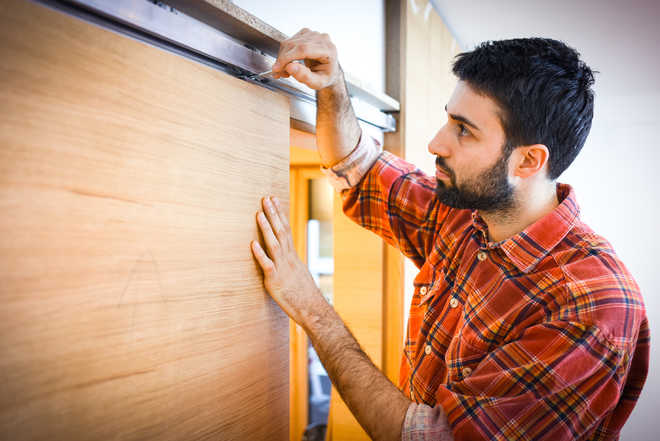
The most popular wood alternative Plywood is most commonly used by the house builder. It further has many types and many qualities.
Jagvir Goyal
A number of wood alternatives are now available in the market for home builders. Let’s have a look at some of these and their possible use in your house.
Plywood
Plywood has become an indispensable item for the house builders. It is produced by gluing together a number of veneers and then compressing them to convert into a single sheet. The veneers are nothing but very thin sheets or slices of timber. The thickness of plywood sheet decides the number of veneers required to be joined together. Several types of plywood are being produced nowadays and each type has its particular use. Separate BIS codes have been formulated for each type. In the houses, marine and flexible plywood are used. Marine plywood has to be as per IS 710, while flexible plywood has to conform to IS 303.
Where to use: Plywood is used in houses in the wooden door panels, cupboards, kitchen cabinets, bathroom vanities, LCD display units, crockery almirahs, furniture, walk-in closets and wood shelfs. For almost every wood item, the carpenter demands plywood of a particular type, size and thickness. The choice of plywood has, therefore, to be made carefully and judiciously.
Block boards
Block board is another wood alternative. These are produced by using wood blocks as the core and veneers as the faces. Wood blocks of same size and thickness are laid together and veneers are fixed with glue on both faces. Block boards are lighter than plywood as soft wood blocks are used in the core normally. Sometimes two sheets of veneer are fixed on each face to make the block boards stronger. A layman may not be able to differentiate between plywood and block boards, unless one examines their edges. These will be made of thin sheets in case of plywood and solid blocks in case of block boards. Block boards used in houses carry IS 1659 mark.
Where to use: Light weight block boards can be used in door panels, furniture, cupboard shutters and partitions. However, these are not very popular among housebuilders. Therefore, block boards are finding more use in building of bus bodies and in prefabricated houses. A house builder may prefer to choose these for hanging shutters of cupboards and almirahs as these cause less load on hinges. Wherever used, care needs to be taken not to drive nails or screws in them.
Particle boards
In particle boards, wood particles such as flakes, granules, splinters are used in the core instead of solid wood. These particles are glued together by using resin to make a solid wooden mass. Particle boards may or may not have veneers as surface material. Particle boards without veneers are manufactured as per IS 3087 specifications, while those with veneers on both faces are manufactured as per IS 3097. These days, pre-laminated particle boards are also being produced. These conform to IS 12823 specifications and are laminated on both faces with impregnated paper or finished foil.
Where to use: Particle boards are not a very popular choice, but still these can be used in cupboards, shelves, closets and panels. Many furniture manufacturers use these in furniture because of the low cost. Normally, furniture manufacturers don’t give long-time guarantee for furniture made from particle board.
MDF
Medium density fibre-board (MDF) has become a common material over the past 20 years. It is produced by using wood fibres got from wood under pressure through a special process. Wood flakes, granules and splinters can also be put to use while manufacturing MDF. Any wood species can be used and suitable synthetic resin and preservatives are used to bind them and no veneers are used on the surface of MDF boards. The required density of MDF is ensured. MDF boards need to carry IS 12406 mark on them to ensure quality. Pre-laminated MDF boards are also available. These need to be as per IS 14587 specifications.
Where to use: MDF is finding extensive use in furniture manufacturing, table tops, partitions, flooring and in false ceilings.
HDF
High density fibre-board (HDF) has higher density than MDF and is stronger. More compressive force is applied to produce HDF and its density is one-and-a-half times more than that of MDF. It also has better moisture resistance properties. No IS mark has been separately assigned to HDF so far.
Where to use: HDF is used for the same items for which MDF is used. It replaces MDF when the customer wants a stronger product of better quality. Apart from furniture and flooring, it is used in factory-manufactured doors by reputed companies.
— The writer is former HoD and engineer-in-chief, Civil Engineering Department in a Punjab PSU



























